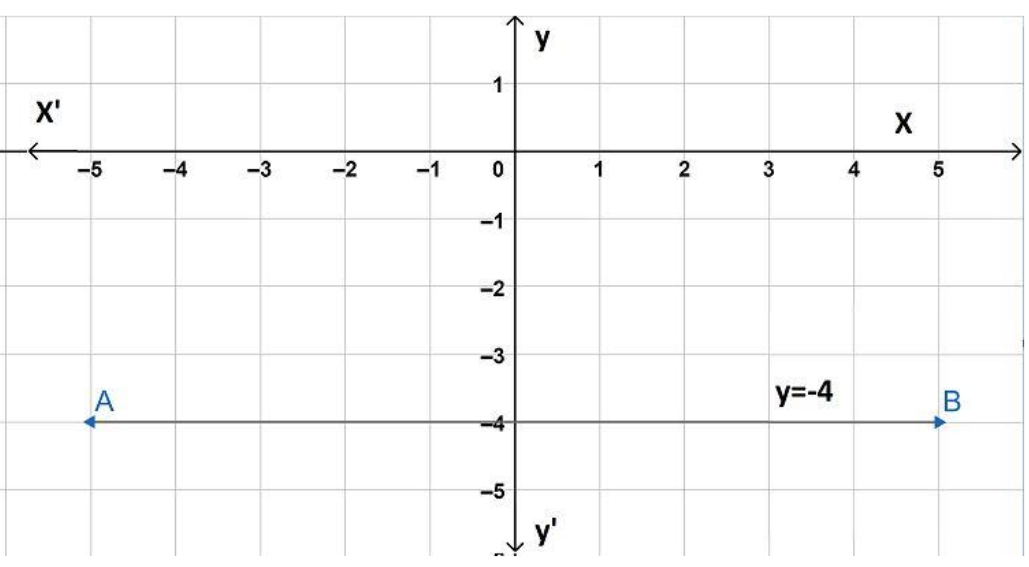
In graphical representation of \[y=-4\] , line is:
A. Parallel to X-axis
B. Parallel to Y-axis
C. Passes through the origin
D. None of these.
Answer
568.8k+ views
Hint: To find the nature of the line \[y=-4\] , we should first draw the graph of this. Here, the coordinate of x is zero. Since the value of y is negative, the line falls below the X-axis. If it is positive, it will fall above the X-axis. From the graph, we can observe the true option.
Complete step-by-step solution
We need to find the nature of the line \[y=-4\]. For this, let us draw the line on the graph.
In the equation \[y=-4\], we know that the value of x coordinate will be zero always.

We can also observe that the value of y is negative. Hence, \[y=-4\] falls below the X-axis. If it was positive, the line would fall above the X-axis. We can see from the figure that \[y=-4\] will be parallel to the x-axis.
In general, any line for which $x$ coordinate is zero, that is for lines $y=a\text{ or }y=-a$, where ‘a’ is a constant, that line will be always parallel to X-axis.
Hence, option A is true.
Now, let us consider option B. It is clear that the line \[y=-4\] is never parallel to the Y-axis. Hence, option B is false.
Let us consider option C. Clearly, from the graph, \[y=-4\] is never passed through the origin.
Hence, the correct option is A.
Note: In lines with one zero coordinate, for example, $y=\pm a\text{ and }x=\pm a$ , where a is a constant, these lines will be parallel to X-axis and Y-axis respectively. For a line to lie on the origin, both the x and y coordinated must be 0.
Complete step-by-step solution
We need to find the nature of the line \[y=-4\]. For this, let us draw the line on the graph.
In the equation \[y=-4\], we know that the value of x coordinate will be zero always.

We can also observe that the value of y is negative. Hence, \[y=-4\] falls below the X-axis. If it was positive, the line would fall above the X-axis. We can see from the figure that \[y=-4\] will be parallel to the x-axis.
In general, any line for which $x$ coordinate is zero, that is for lines $y=a\text{ or }y=-a$, where ‘a’ is a constant, that line will be always parallel to X-axis.
Hence, option A is true.
Now, let us consider option B. It is clear that the line \[y=-4\] is never parallel to the Y-axis. Hence, option B is false.
Let us consider option C. Clearly, from the graph, \[y=-4\] is never passed through the origin.
Hence, the correct option is A.
Note: In lines with one zero coordinate, for example, $y=\pm a\text{ and }x=\pm a$ , where a is a constant, these lines will be parallel to X-axis and Y-axis respectively. For a line to lie on the origin, both the x and y coordinated must be 0.
Recently Updated Pages
Master Class 9 Social Science: Engaging Questions & Answers for Success

Master Class 9 Science: Engaging Questions & Answers for Success

Master Class 9 English: Engaging Questions & Answers for Success

Master Class 9 Maths: Engaging Questions & Answers for Success

Master Class 9 General Knowledge: Engaging Questions & Answers for Success

Class 9 Question and Answer - Your Ultimate Solutions Guide

Trending doubts
Which places in India experience sunrise first and class 9 social science CBSE

Fill the blanks with the suitable prepositions 1 The class 9 english CBSE

Write the 6 fundamental rights of India and explain in detail

Difference Between Plant Cell and Animal Cell

What is pollution? How many types of pollution? Define it

What is the Full Form of ISI and RAW




